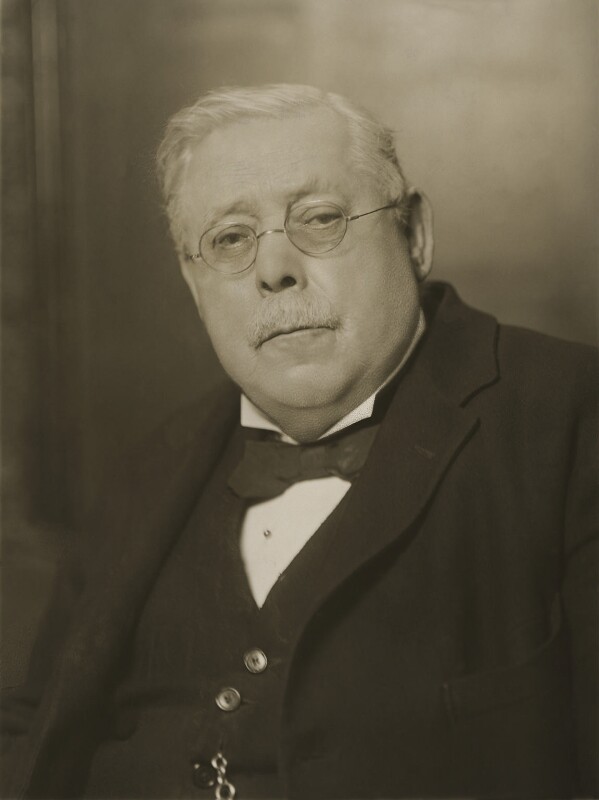
Sir Ernest Wallis Budge in 1930, a bromide print by Bassano Ltd.
© National Portrait Gallery London (NPG 83980),
by kind permission.
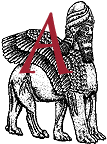
t first glance, the life of Sir Ernest Alfred Thompson Wallis Budge (1857–1934) is like something out of Samuel Smiles's Self-Help: born and brought up in Bodmin, Cornwall, the child of a single mother, young Ernest left school at twelve, but through determination, genius and hard work became one of the leading Egyptologists of the age. This is all perfectly true. But it is rather misleading. For example, Budge himself, looking back, saw his path in life almost set out for him. "Love for the East and for the things of the East was born in me," he writes in his memoir, explaining that generations of his forbears had served in the East India Company (By Nile and Tigris I: 3). Moreover, his headmaster, who was a relative, gave his pupils the run of his amazing library, well stocked with the classics and various grammar books, leading the boy into a study of Hebrew. This same enlightened headmaster duly contacted the orientalist Charles Seager (1808-1878) for guidance in his studies, and the boy furthered his interests under Seager's supervision for several years, until the latter's death.
Budge had many other helping hands. Seager had taken him to meet Samuel Birch (1813-1885). Birch was none other than the Keeper of Oriental Antiquities at the British Museum, and he let the unusually talented youth study cuneiform tablets under his supervision. Meanwhile, Birch's assistant, the pioneering Assyriologist George Smith (1840-1876), helped him with Assyrian. During this period (1870-78), Budge was earning his keep as a warehouse clerk for W. H. Smith; but at lunchtime he found the nearby St Paul's Cathedral a quiet place to study, and there too his diligence attracted attention: the organist, at that time the highly reputed composer John Stainer (1840-1901), began to make efforts on his behalf. With the backing of this galaxy of influential mentors, Seager, Birch, Smith, Stainer and others, including Gladstone himself, Budge was able to present himself in Cambridge for the full-time formal education he deserved.
By the time Budge went up to the university in 1880, he was several years older than most of his peers. But he had already begun his prolific writing career. According to his obituary in the Journal of the Royal Asiatic Society, his first publication, Assyrian Incantations, had appeared in 1878. The British Library catalogue has only a tentative, and later, date for this; but it gives firm dates for two more books which came out in 1880, the year of Budge's entry to academe. Here, he soon made up for lost time. In the following year he became a scholar of Christ's College, and did well there, if not quite as brilliantly as his sponsors had hoped (see Reade 446). The very year that he went down from Cambridge (1883), he became an assistant in the British Museum's Department of Oriental Antiquities. He married his wife, Dora Helen, that same year. He was now set up for life. In 1894 he was promoted to keeper to what was then, after reorganisation, the Department of Egyptian and Assyrian Antiquities. There he stayed until he retired in 1924, laden with honours: honorary doctorates from Cambridge, Oxford (where he had been made a member of University College in 1898) and Durham, as well as the knighthood bestowed on him in 1920.
Judgments about his time in office are mixed. "As an official of the British Museum," writes one biographer, "Budge devoted himself whole-heartedly to its service. He worked zealously to expand the museum's collections of Egyptian and western Asiatic antiquities, display them for the benefit of the general public, and make the more significant texts and objects available to scholars in the form of printed editions and catalogues" (Smith). The British Museum, too, has much to say in his favour:
"Budge" energetically acquired a large number of antiquities and manuscripts during the course of his work in Egypt and Mesopotamia. His three trips to these countries in 1887, 1888 and 1890 are described rather colourfully in his book By Nile and Tigris (London, 1920). He gained the Arabic nicknames of "Father of Skulls" and "Father of Antiquities" as a direct result of his collecting activities in Egypt and Sudan. He was a prolific writer on Assyriological and Egyptological matters, and edited Syriac and Ethiopian manuscripts.
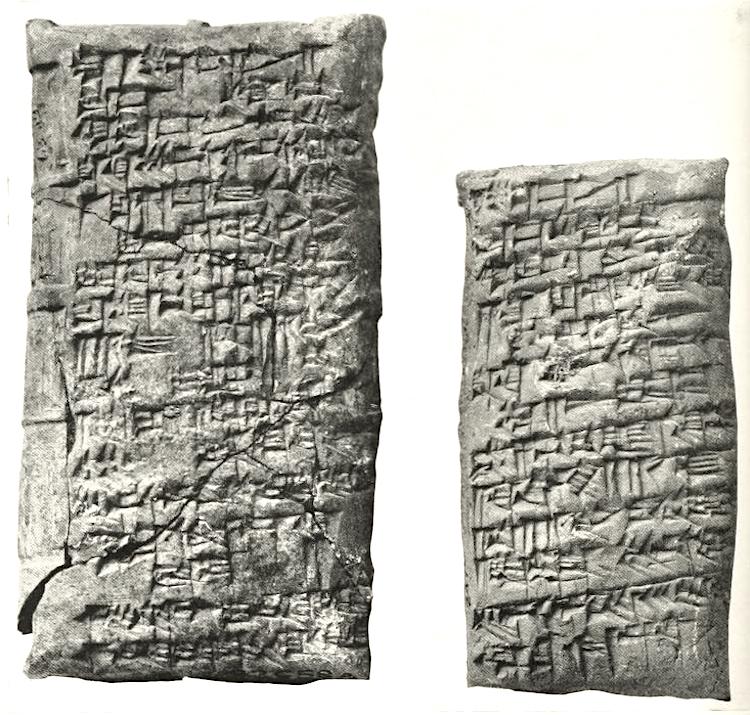
A Babylonian tablet and its case, on the page facing Budge's description of evading officials (By Nile and Tigris, facing p. 235).
However, as Julian Reade suggests, "[h]e was a more controversial figure than a simple list of his achievements indicates" (445). Even for the times, his acquisition methods were questionable. His duties in London precluded long periods of excavation at the key sites, and much of what he brought back from these excursions was bought rather than found, often through dealers. His enormous contribution to the Museum's collections, which ranged from statues to papyri, was apt to be cursorily documented, sometimes with doubtful accuracy. Worse, "a number of his more important Egyptian acquisitions were removed from that country without ever having passed through customs. Under the laws then in force, their shipment abroad would have been prohibited" (Smith). This was something of which he was certainly aware. He was quite open about it, seeking to justify it on several grounds. The items he procured came from British excavations, he claimed, and had probably been carried off without payment. But it was only by subterfuge that he could ship them home. In By Nile and Tigris, he describes how he got hold of the tablets from Abu Habbah and loaded them up for transit "after nightfall by the ladder on the side of the ship which did not face the official buildings" (235). In writing about it so openly, he clearly expected the British Museum to attach as little blame to his behaviour as he did himself.
Ironically, Budge was quick to condemn such activities when he perceived them elsewhere. This led to a successful libel case against him, brought by the archaeologist and diplomat Hormuzd Rassam (1826-1910) in 1893. The outcome of the case is instructive: "While the jury found in Rassam’s favour, it only awarded him £50 damages rather than the £1000 claimed. The money was recovered for Budge through a public subscription; many contributors were Museum staff, either because they supported Budge or because they thought it prudent to do so" (Reade 485). The case did not stand in the way of his final promotion to Keeper in the following year.
Budge's written work, too, is open to both praise and criticism. His output was not only vast but varied — its range is as breathtaking as its quantity. He wrote for everyone, from enthusiastic amateurs, visitors to the Museum and travellers, to students and scholars. And his pen was never idle. He became a byword for industry, lampooned in Punch for his long entry in Who's Who, which had more than a column of publications, but failed to mention any recreations:
WHEN back from Bloomsbury you trudge,
What do you do, Professor BUDGE?
Are you, perchance, that patient drudge
Who plays at chess, O learned BUDGE?
Or do you every minute grudge
That's spent away from golf, good BUDGE?
And when the links are thick with sludge,
Do you go rinking, ERNEST BUDGE?
(To such inquiries, "Faugh!" or "Fudge!"
Briefly replies E. WALLIS BUDGE.)
Amara Thornton points out that he published with "Thomas Cook & Sons [for whom he revised the Tourist's Handbook for Egypt and the Sudan in 1883], Chatto & Windus, J. M. Dent & Co, Gowans & Gray, Kegan Paul, Martin Hopkinson, the Medici Society, Methuen, John Murray and the Religious Tract Society" (9). Thornton later mentions, in addition, his "popular guide" to Tutankhamen Amenism, Atenism and Egyptian Monotheism for Macmillan, published in 1923 (11). That year he even published a book of Egyptian fairy tales, translated from papyri.
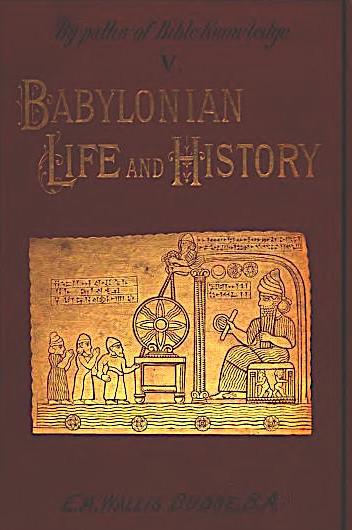
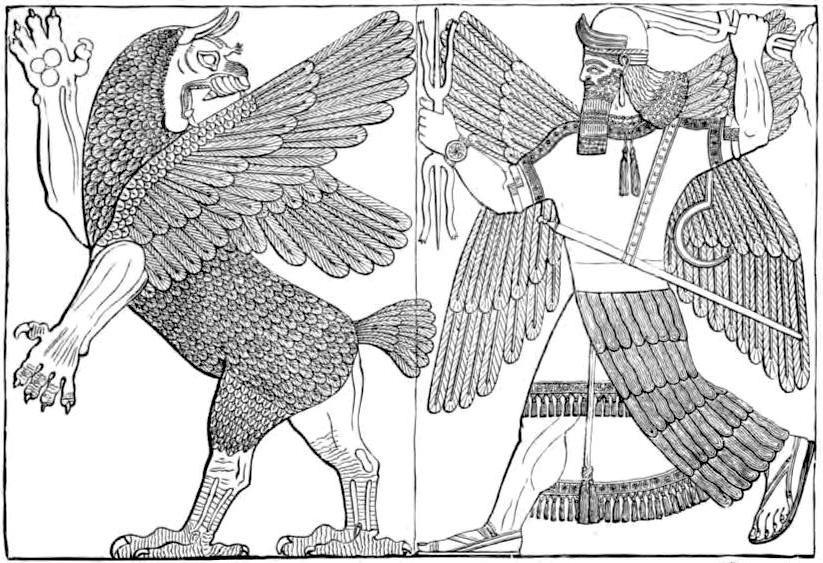
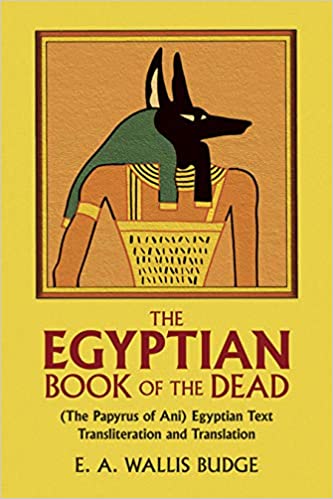
Left to right: (a) Binding of one of the many books by Budge in the Internet Archive: Babylonian Life and History (1884). (b) Frontispiece of the same book: "The Fight between Merodach (Bel) and the Dragon." (c) One of Budge's best-selling works today, even though there are now more up-to-date editions.
Like his documentation of items in the museum's collections, his written work suffers from inaccuracies, and no doubt for the same reasons — the sheer scale and pace of his endeavours. There was also more than a hint of over-reliance on others' work (see Reade 448). Some of this was noted in his own lifetime, and not a few of his findings have since been revised and updated in light of later scholarship and discoveries. Nevertheless, "it is thanks to him that a number of texts of fundamental importance were first made available to scholarship" (Smith). As well as writing, he gave talks about his discoveries, such as one on "The Moral and Religious Literature of Ancient Egypt," announced for the Royal Institution in the Court Circular of the Times of 30 May 1896, for 3 pm that day (the first of two lectures). His ideas were therefore widely disseminated, and influenced authors as different as his friends Rider Haggard and Edith Nesbit, and Sir James Frazer of The Golden Bough fame. The dedication of Nesbit's The Story of the Amulet (1907) reads, "To Dr Wallis Budge of the British Museum this book is dedicated as a small token of gratitude for his unfailing kindness and help in the making of it."
Much of Budge's own work is still in print. To judge by their ratings and reviews, a number of his individual books are still popular. Among them is The Mummy: Chapters on Egyptian Funereal Archaeology (1893). At its first appearance, it struck a chord in an era of increased interest in life "on the other side"; and, as Alan Short said later, perhaps with the more comprehensive edition of 1925 in mind, "as a manual of funerary archaeology it has no equal" (438).
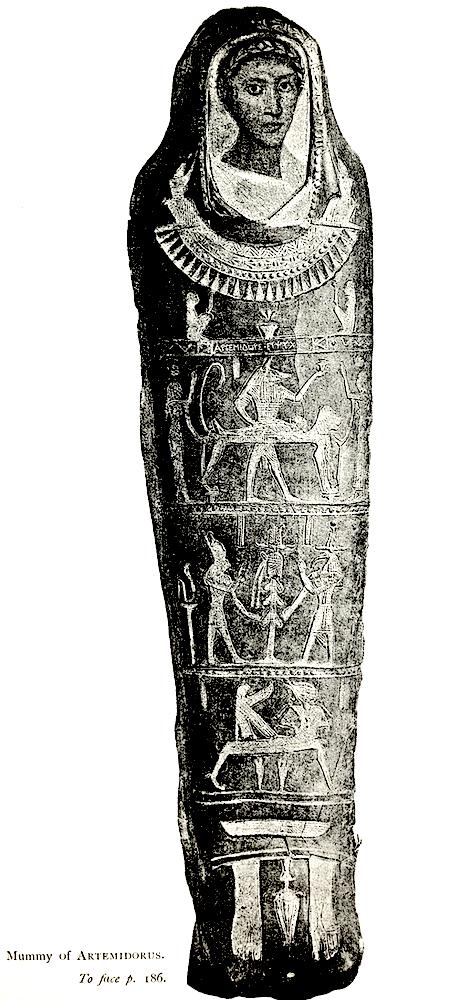
Mummy of Artemidorus, in The Mummy, facing p. 186.
The boy from Bodmin had prospered and won an important place in the history of Egyptology. If took some short cuts and made some enemies along the way, it is not very surprising: "Wallis Budge was far from the only Briton who found ingenious ways of packing crates so that potential museum pieces would be missed by all but the most officious customs officials" (Gange 172) — another, less dramatic ploy. In smuggling items into England, he was taking advantage of attitudes only later deplored; restitution remains a very problematic area.
Predeceased by his wife, Budge died at 16 Fitzroy Square, London, on 23 November 1934. The couple had been childless, but he left another kind of legacy — foundations for fellowships in Egyptology in his wife's name at both Oxford and Cambridge. A memorial service was held at St Paul's, but he was buried, like his wife, at Nunhead cemetery.
Related Material
- Introduction to Victorian Archaeology: Excavators, Artifacts, Politics (discusses the "licensed plunder" that went on)
- Introduction to Victorian Archaeology: Beyond Heroic Narratives and Splendid Artifacts (introduces Birch, George Smith and Rassam)
- Archaeology in Victorian Popular Culture and Visual Art
- Archaeology as a Discipline (the raising of academic standards, the development of methodologies and so on)
- Victorian Spiritualism — Proponents and Exponents (controversies over communication with the dead)
Bibliography
Budge, E. A. Wallis. Babylonian Life and History. London: The Religious Tract Society, 1884. Internet Archive. Harvard University Library. Web. 1 September 2021.
_____. By Nile and Tigris: A Narrative of Journeys in Egypt and Mesopotamia on Behalf of the British Museum between the Years 1886 and 1913. London: Murray, 1920. Internet Archive. Robarts Library, University of Toronto. Web. 1 September 2021.
_____. Mummy: Chapters on Egyptian Funereal Archeology. Cambidge: Cambridge University Press, 1893. Internet Archive. Harold B. Lee Library, Brigham Young University. Web. 1 September 2021.
Gange, David. Dialogues with the Dead: Egyptology in British Culture and Religion, 1822-1922. Oxford: Oxford University Press, 2013.
Ismail, Matthew. Wallis Budge: Magic and Mummies in London and Cairo. Glasgow: Hardinge Simpole Publishing, 2011.
"Lines to Professor Budge." Punch. Vols. 138-39. 21 December 1910. 446. Internet Archive. Robarts Library, University of Toronto. Web. 1 September 2021.
Reade, Julian. "Afterword: Wallis Budge — For or Against." In Ismail. 444-63.
Shorter, Alan W. "Obituary Notice: Ernest A. Wallis Budge." The Journal of the Royal Asiatic Society of Great Britain and Ireland. 2 (1935): 436-38. Accessed via Jstor. Web. 1 August 2021.
Sir Ernest A. T. Wallis Budge British Museum. Web. 1 September 2021.
Thornton, Amara. Archaeologists in Print: Publishing for the People. London: UCL Press, 2018.
The Times Digital Archive (Gale Research).
Created 1 September 2021